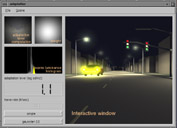|
|
Images of interactive sessions



|
|
|
Tone mapping and visual adaptation are crucial for the generation of static, photorealistic images. A largely unexplored problem is the simulation of adaptation and its changes over time on the visual appearance of a scene. These changes are important in interactive applications, including walkthroughs or games, where effects such as dazzling, slow dark-adaptation, or more subtle effects of visual adaptation can greatly enhance the immersive impression. In applications such as driving simulators, these changes must be modeled in order to reproduce the visibility conditions of real-world situations. In this paper, we address the practical issues of interactive tone mapping and propose a simple model of visual adaptation.
We describe a multi-pass interactive rendering method that computes the average luminance in a first pass and renders the scene with a tone mapping operator in the second pass. We also propose several extensions to the tone mapping operator of Ferwerda et al. [Ferwerda 1996]. We demonstrate our model for the display of global illumination solutions and for interactive walkthroughs.
|
|
|
|
The angle theta is in degrees, not radians.
And there is a missing 19.75 term in the equation of f3. It should read:
f3(theta, lambda)=436.9*568/lambda * exp(-19.75*(theta-3*lambda/568)**2)
Thanks to Simon Winder who pointed it out.
|
|
@inProceedings{Durand:2000:ITM,
author = {Fr\'edo Durand and Julie Dorsey},
title = {Interactive Tone Mapping},
journal = {Proceedings of the Eurographics Workshop on Rendering},
year = {2000},
month = jun,
publisher = {Springer Verlag
note = {Held in Brno, Czech Republic},
keywords = {tone mapping, human perception, flare},
}
|
|